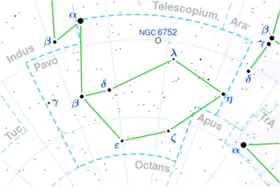Astronomy:Pi Pavonis
| Observation data Equinox J2000.0]] (ICRS) | |
|---|---|
| Constellation | Pavo |
| Right ascension | 18h 08m 34.81459s[1] |
| Declination | −63° 40′ 06.7906″[1] |
| Apparent magnitude (V) | 4.33[2] |
| Characteristics | |
| Spectral type | kA4hF0mF2 III[3] |
| U−B color index | +0.17[4] |
| B−V color index | +0.23[4] |
| Astrometry | |
| Radial velocity (Rv) | −15.60[5] km/s |
| Proper motion (μ) | RA: +18.02[1] mas/yr Dec.: -207.57[1] mas/yr |
| Parallax (π) | 25.09 ± 0.17[1] mas |
| Distance | 130.0 ± 0.9 ly (39.9 ± 0.3 pc) |
| Absolute magnitude (MV) | 1.33[2] |
| Details | |
| Mass | 2.15[6] M☉ |
| Radius | 2.84+0.42 −0.03[7] R☉ |
| Luminosity | 24.69±0.36[7] L☉ |
| Surface gravity (log g) | 3.81[8] cgs |
| Temperature | 7,632+50 −510[7] K |
| Metallicity [Fe/H] | 0.27[8] dex |
| Rotational velocity (v sin i) | 30.0[9] km/s |
| Age | 630[6] Myr |
| Other designations | |
| Database references | |
| SIMBAD | data |
π Pavonis, Latinized as Pi Pavonis, is a candidate astrometric binary[11] star system in the constellation Pavo. It is a white-hued star that is visible to the naked eye as a faint point of light with an apparent visual magnitude of 4.33.[2] The distance to this object is 130 light years based on parallax,[1] but it is drifting closer to the Sun with a radial velocity of −15.6 km/s.[5]
The visible component is an chemically peculiar star that displays an abundance anomaly of strontium.[12][13] Grey et al. (1989) classify it as kA4hF0mF2 III,[3] matching a giant Am star with the calcium K line of an A4 star, the hydrogen lines of a cooler F0 star, and the metal lines of a F2 star. However, Loden and Sundman (1989) don't consider it to be a giant and list it as an Ap star.[12] It is 630[6] million years old with 2.15[6] times the mass of the Sun and 2.8[7] times the Sun's radius. The star is radiating 24.7[7] times the Sun's luminosity from its photosphere at an effective temperature of 7,632 K.[7]
References
- ↑ 1.0 1.1 1.2 1.3 1.4 1.5 Van Leeuwen, F. (2007). "Validation of the new Hipparcos reduction". Astronomy and Astrophysics 474 (2): 653–664. doi:10.1051/0004-6361:20078357. Bibcode: 2007A&A...474..653V. Vizier catalog entry
- ↑ 2.0 2.1 2.2 Anderson, E.; Francis, Ch. (2012). "XHIP: An extended hipparcos compilation". Astronomy Letters 38 (5): 331. doi:10.1134/S1063773712050015. Bibcode: 2012AstL...38..331A. Vizier catalog entry
- ↑ 3.0 3.1 Gray, R. O.; Garrison, R. F. (1989). "The early F-type stars - Refined classification, confrontation with Stromgren photometry, and the effects of rotation". Astrophysical Journal Supplement Series 69: 301. doi:10.1086/191315. Bibcode: 1989ApJS...69..301G.
- ↑ 4.0 4.1 Mermilliod, J. C. (2006). "VizieR Online Data Catalog: Homogeneous Means in the UBV System (Mermilliod 1991)". VizieR On-line Data Catalog: II/168. Originally Published in: Institut d'Astronomie 2168. Bibcode: 2006yCat.2168....0M.Vizier catalog entry
- ↑ 5.0 5.1 Wilson, R. E. (1953). "General Catalogue of Stellar Radial Velocities". Carnegie Institute Washington D.C. Publication (Carnegie Institution of Washington). Bibcode: 1953GCRV..C......0W.
- ↑ 6.0 6.1 6.2 6.3 De Rosa, R. J.; Patience, J.; Wilson, P. A.; Schneider, A.; Wiktorowicz, S. J.; Vigan, A.; Marois, C.; Song, I. et al. (2013). "The VAST Survey - III. The multiplicity of A-type stars within 75 pc". Monthly Notices of the Royal Astronomical Society 437 (2): 1216. doi:10.1093/mnras/stt1932. Bibcode: 2014MNRAS.437.1216D.
- ↑ 7.0 7.1 7.2 7.3 7.4 7.5 Brown, A. G. A. (August 2018). "Gaia Data Release 2: Summary of the contents and survey properties". Astronomy & Astrophysics 616: A1. doi:10.1051/0004-6361/201833051. Bibcode: 2018A&A...616A...1G. Gaia DR2 record for this source at VizieR.
- ↑ 8.0 8.1 Erspamer, D.; North, P. (February 2003). "Automated spectroscopic abundances of A and F-type stars using echelle spectrographs. II. Abundances of 140 A-F stars from ELODIE". Astronomy and Astrophysics 398 (3): 1121–1135. doi:10.1051/0004-6361:20021711. Bibcode: 2003A&A...398.1121E.
- ↑ Glebocki, R.; Gnacinski, P. (2005). "VizieR Online Data Catalog: Catalog of Stellar Rotational Velocities (Glebocki+ 2005)". VizieR On-line Data Catalog: III/244. Originally Published in: 2005csss...13..571G; 2005yCat.3244....0G 3244. Bibcode: 2005yCat.3244....0G. Vizier catalog entry
- ↑ "pi Pav". SIMBAD. Centre de données astronomiques de Strasbourg. http://simbad.u-strasbg.fr/simbad/sim-basic?Ident=pi+Pav.
- ↑ Eggleton, P. P.; Tokovinin, A. A. (September 2008). "A catalogue of multiplicity among bright stellar systems". Monthly Notices of the Royal Astronomical Society 389 (2): 869–879. doi:10.1111/j.1365-2966.2008.13596.x. Bibcode: 2008MNRAS.389..869E.
- ↑ 12.0 12.1 Loden, L. O.; Sundman, A. (June 1989). "Giant CP stars?". Journal of Astrophysics and Astronomy 10 (2): 183–196. doi:10.1007/BF02719315. Bibcode: 1989JApA...10..183L.
- ↑ Renson, P.; Manfroid, J. (2009). "Catalogue of Ap, Hg Mn and Am stars". Astronomy and Astrophysics 498 (3): 961. doi:10.1051/0004-6361/200810788. Bibcode: 2009A&A...498..961R. https://zenodo.org/record/890529.
 |


